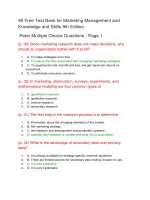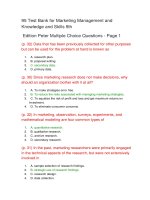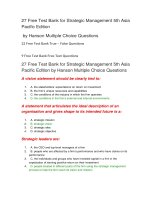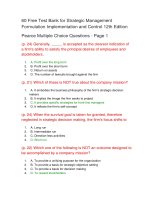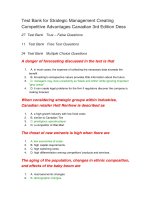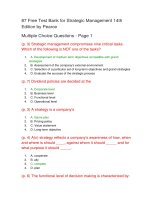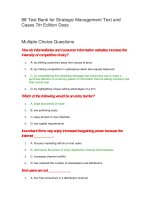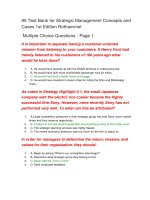97 test bank for strategic management and business policy globalization innovation and sustainability 14th edition wheelen
Bạn đang xem bản rút gọn của tài liệu. Xem và tải ngay bản đầy đủ của tài liệu tại đây (135.03 KB, 24 trang )
97 Test Bank for Strategic Management and Business
Policy Globalization Innovation and Sustainability 14th
Edition Wheelen
Multiple Choice Questions - Page 1
More than ________ of outside directors surveyed said that they had been
named as part of a lawsuit against the corporation.
1.
A) 40%
2.
B) 50%
3.
C) 60%
4.
D) 70%
5.
E) 80%
The vast majority of inside directors are from all of the following EXCEPT
1.
A) lower-level operating employee.
2.
B) president of the corporation.
3.
C) vice-president of operational units.
4.
D) chief executive officer.
5.
E) vice-president of functional units.
An agency problem can occur when
1.
2.
3.
4.
A) the desires and objectives of the owners and agents conflict.
B) it is difficult or expensive for the owners to verify what the agent is actually
doing.
C) the owners and agents have different attitudes toward risk.
D) executives do not select risky strategies because they fear losing their jobs if
the strategy fails.
5.
E) all of the above
According to the text, most publicly owned large corporations today tend
to have boards with what degree of involvement in the strategic
management process?
1.
A) passive to minimal
2.
B) minimal to nominal
3.
C) rubber stamp type
4.
D) nominal to active
5.
E) active to catalyst
Which of the following statements is true regarding the board of
directors?
1.
A) The board is charged by law to act with due care.
2.
B) If a director or the board as a whole fails to act with due care and, as a result,
the corporation is in some way harmed, the careless director or directors can be
held personally liable for the harm done.
3.
C) Director liability insurance is often needed to attract people to become
members of boards.
4.
D) Directors must be aware of the needs of various constituent groups to balance
all their interests.
5.
E) all of the above
The theory which states that problems arise in corporations because top
management no longer is willing to bear the brunt of their decisions
unless they own a substantial amount of stock in the corporation is called
1.
A) codetermination.
2.
B) agency theory.
3.
C) interlocking management theory.
4.
D) strategic leadership theory.
5.
E) ownership theory.
The relationship among the board of directors, top management, and
shareholders is referred to as
1.
A) corporate synergy.
2.
B) corporate management.
3.
C) corporate governance.
4.
D) corporate strategy.
5.
E) corporate responsibility.
The ________ boards typically never initiate or determine strategy unless
a crisis occurs.
1.
A) rubber stamp
2.
B) active participation
3.
C) catalyst
4.
D) nominal participation
5.
E) minimal review
When a board of directors is involved to a limited degree in the
performance or review of selected key decisions, indicators, or programs
of management, the degree of involvement is referred to as
1.
A) rubber stamp.
2.
B) nominal participation.
3.
C) active participation.
4.
D) minimal review.
5.
E) phantom.
Surveys of LARGE U.S. and Canadian corporations found outsiders make
up what percentage of total board membership?
1.
A) 2%
2.
B) 30%
3.
C) 50%
4.
D) 80%
5.
E) 98%
A highly involved board does all of the following EXCEPT
1.
A) tends to be very active.
2.
B) provides advice when necessary.
3.
C) keeps management alert.
4.
D) takes their tasks of initiating and determining strategy very seriously.
5.
E) manage the every day operations of the organization.
The percentage of directors of small, publicly held U.S. corporations
which are outsiders is approximately
1.
A) 2 - 12%.
2.
B) 20 - 40%.
3.
C) 40 - 60%.
4.
D) 60 - 80%.
5.
E) 98 - 100%.
From the perspective of the public, the primary job of the board of
directors is
1.
A) to lend credence to the decisions of the executive committee.
2.
B) dictated solely by legal requirements.
3.
C) to act as representatives for public identification.
4.
D) to closely monitor the actions of management.
5.
E) insulated from legal judgments because management actually makes the
decisions.
Catalyst-level board of directors typically
1.
2.
A) are less involved than active participation boards.
B) take leading roles in establishing and modifying the company mission,
objectives, and strategy.
3.
C) are involved in a limited degree of key decision making.
4.
D) are held to a greater degree of legal responsibility.
5.
E) experience more financial success than less involved boards.
Outside directors are defined as
1.
A) those individuals who scan the external environment.
2.
B) individuals on the board who are not employed by the board's corporation.
3.
C) those individuals with public relations responsibilities.
4.
D) board members who are also officers or executives employed by the
corporation.
5.
E) individuals who organize and coordinate politically focused activities.
Which of the following regions is the most globalized region of the world
in terms of boards of directors with most companies having one or more
non-national directors?
1.
A) Asia
2.
B) Middle East
3.
C) North American
4.
D) Pacific Rim
5.
E) Europe
Codetermination
1.
2.
A) is the process by which both management and the board establish corporate
strategic management.
B) is the inclusion of a corporation's employees on its board.
3.
C) occurs when one or more individuals on one board also serve on other boards.
4.
D) is present when all board members are also employed by the corporation.
5.
E) occurs when minority shareholders concentrate their votes.
A study by Korn/Ferry found that ________ of U.S. boards of directors had
at least one ethnic minority member in 2007.
1.
A) 6%
2.
B) 26%
3.
C) 47%
4.
D) 78%
5.
E) 96%
________ theory argues that senior executives over time tend to view the
corporation as an extension of themselves.
1.
A) Population ecology
2.
B) Motivation
3.
C) Stewardship
4.
D) Agency
5.
E) Goal setting
What percentage of the 100 largest companies listed in 2011 had boards
of directors with at least one woman member?
1.
A) 4%
2.
B) 20%
3.
C) 50%
4.
D) 82%
5.
E) 96%
Sixty-six percent of the outstanding stock in the largest U.S. and UK
corporations is now owned by
1.
A) family directors.
2.
B) affiliated directors.
3.
C) institutional investors.
4.
D) retired directors.
5.
E) management directors.
The average board member of a U.S. Fortune 500 firm serves on ________
board(s).
1.
A) 3
2.
B) 6
3.
C) 9
4.
D) 12
5.
E) only 1
Which of the following is NOT a task of the board of directors in strategic
management?
1.
A) to monitor
2.
B) to implement
3.
C) to influence
4.
D) to initiate and determine
5.
E) to evaluate
A careless director or directors can be held personally liable for harm
done to the corporation if they failed to act with
1.
A) codetermination.
2.
B) figurehead role.
3.
C) cumulative voting.
4.
D) accountability.
5.
E) due care.
Which country pioneered the use of worker participation on corporate
boards?
1.
A) England
2.
B) France
3.
C) Sweden
4.
D) Japan
5.
E) Germany
Research reveals that the likelihood of a firm engaging in illegal behavior
or being sued declines
1.
A) with a larger board.
2.
B) with the addition of insiders on the board.
3.
C) with the addition of outsiders on the board.
4.
D) with a smaller board.
5.
E) with a well-compensated board.
What percentage of public corporations have periodic board meetings
devoted primarily to the review of overall strategy?
1.
A) 24%
2.
B) 34%
3.
C) 44%
4.
D) 64%
5.
E) 74%
Board members who are not employed by the corporation, but handle the
legal or insurance needs of the firm and are thus not true "outsiders," are
what kind of directors?
1.
A) affiliated directors
2.
B) family directors
3.
C) retired directors
4.
D) management directors
5.
E) interlocked directors
The requirements of a board of directors vary significantly by country and
by state; however, there is a developing consensus as to what the major
responsibilities should be. Which of the following is NOT one of the
responsibilities?
1.
A) effective board leadership including the processes, makeup and output of the
board
2.
B) strategy of the organization
3.
C) risk vs. initiative and the overall risk profile of the organization
4.
D) becoming directly involved in managerial decisions
5.
E) sustainability
According to ________ theory, ________ directors tend to identify with the
corporation.
1.
A) agency; inside
2.
B) corporate governance; inside
3.
C) stewardship; inside
4.
D) corporate governance; affiliated
5.
E) stewardship; outside
60 Free Test Bank for Strategic Management and
Business Policy Globalization Innovation and
Sustainability 14th Edition Wheelen Multiple Choice
Questions - Page 2
All of the following are true of overconfident CEOs EXCEPT
1.
A) overconfident CEOs tend to charge ahead with mergers and acquisitions even
though they are aware that most acquisitions destroy shareholder value.
2.
B) overconfident CEOs view their company as undervalued by outside investors.
3.
C) overconfident CEOs are more likely to do deals that diversify their firm's lines of
businesses.
4.
5.
D) the overconfidence of CEOs may lead to hubris.
E) overconfident CEOs were less likely to make an acquisition when they could
avoid selling new stock to finance them.
The New York Stock Exchange (NYSE) requires corporations to have
1.
A) a majority of the board be outsiders.
2.
B) cumulative voting.
3.
C) at least one employee director as a representative on the board.
4.
D) at least two outside directors providing stockholder representation.
5.
E) an audit committee composed entirely of independent, outside members.
According to the text, which of the following is NOT a typical standing
committee of boards of directors?
1.
A) audit committee
2.
B) compensation committee
3.
C) executive committee
4.
D) nominating committee
5.
E) public relations committee
According to a survey of 156 large corporations, in what percentage of the
firms were strategies first proposed in business units and then sent to
headquarters for approval?
1.
A) 10%
2.
B) 36%
3.
C) 50%
4.
D) 66%
5.
E) 96%
A lead director
1.
A) has not been a popular approach in the United Kingdom.
2.
B) creates a balance of power when the CEO is also Chair of the Board.
3.
C) has lost popularity in the United States since 2003.
4.
D) has no involvement in the CEO's evaluation.
5.
E) totally replaces the CEO position.
Which of the following is NOT a key characteristic of transformational
executive leaders?
1.
A) The CEO presents a role for others to identify with and to follow.
2.
B) The CEO communicates high performance standards for all employees.
3.
C) The CEO demonstrates confidence in the employees' abilities to meet the
expressed high standards.
4.
D) The CEO energizes the board to formulate strategy.
5.
E) The CEO articulates a strategic vision for the corporation.
According to the text, one of the primary responsibilities of top
management in strategic management is
1.
A) ensuring that day-to-day operations are efficient and well run.
2.
B) providing executive leadership.
3.
C) balancing the budget.
4.
D) managing the short-term planning process.
5.
E) making all important decisions.
The U.S. Clayton Act and Banking Act of 1933
1.
A) promote interlocking directorates by U.S. companies to foster better
communications and working relationships.
2.
B) prohibit acts or contracts tending to create a monopoly.
3.
C) prevent unfair practices in interstate commerce.
4.
D) promote racial parity on the board of directors.
5.
E) prohibit interlocking directorates by U.S. companies competing in the same
industry.
The percentage of CEOs of the 100 largest companies who also serve as
chairman of the board is
1.
A) less than 10%.
2.
B) approximately 20%.
3.
C) approximately 50%.
4.
D) approximately 68%.
5.
E) over 90%.
All of the following criteria reflect survey findings of the characteristics of
a good director EXCEPT
1.
A) willing to challenge management when necessary.
2.
B) expertise on global business issues.
3.
C) understands the firm's key technologies and processes.
4.
D) available for outside meetings to advise management.
5.
E) willing to always agree with executive decisions.
Under what circumstances does an INDIRECT interlocking directorate
exist?
1.
2.
3.
A) when both management and the board establish corporate strategic
management
B) when a corporation's employees are included on its board
C) when one or more individuals on one board also serve on a board of a second
firm
4.
D) when all board members are also employed by the corporation
5.
E) when two corporations have directors who serve on the board of a third firm
The role of the board of directors in the strategic management of the
corporation is likely to
1.
A) be more active in the future.
2.
B) be less active in the future.
3.
C) be nonexistent as planning departments take over.
4.
D) remain the same.
5.
E) shift more toward managing daily operations.
Which of the following is NOT descriptive of interlocking directorates?
1.
2.
A) Interlocking directorates occur because large firms have a large impact on
other corporations.
B) Interlocking directorates are more common in small, family-owned companies.
3.
C) Interlocking directorates are a useful method for gaining inside information
about an uncertain environment.
4.
D) Interlocking directorates occur in about 20% of the 1000 largest US firms.
5.
E) Interlocking directorates provide objective expertise about a firm's strategy.
Under what circumstances does a DIRECT interlocking directorate exist?
1.
A) when both management and the board establish corporate strategic
management
2.
3.
B) when a corporation's employees are included on its board
C) occurs when two firms share a director or when an executive of one firm sits on
the board of a second firm
4.
D) when all board members are also employed by the corporation
5.
E) when two corporations have directors who serve on the board of a third firm
The concept of the lead director originated in
1.
A) the United Kingdom.
2.
B) the United States.
3.
C) France.
4.
D) Sweden.
5.
E) Germany.
The percentage of large U.S. corporations using nominating committees
to identify potential new directors is approximately
1.
A) less than 6%.
2.
B) 37%.
3.
C) 57%.
4.
D) 87%.
5.
E) 97%.
According to the research, in turbulent environments, the best type of
planning is
1.
A) top-down strategic planning.
2.
B) bottom-up strategic planning.
3.
C) horizontal strategic planning.
4.
D) concurrent strategic planning.
5.
E) composite strategic planning.
Which of the following is NOT a trend in corporate governance expected
to continue?
1.
A) Institutional investors are becoming active on boards.
2.
B) Boards are getting more involved in shaping company strategy.
3.
C) Boards are getting larger.
4.
5.
D) Shareholders are demanding that directors and top managers own more than
token amounts of stock in the corporation.
E) Outside directors are taking charge of annual CEO evaluations.
Which of the following is NOT one of the four major issues researched by
the S & P Corporate governance Scoring System?
1.
A) ownership structure and influence
2.
B) research and development initiatives
3.
C) financial stakeholder rights and relations
4.
D) financial transparency and information disclosures
5.
E) board structure and processes
A staggered board
1.
A) increases the chances of a hostile takeover.
2.
B) has only a portion of the board stand for election each year.
3.
C) makes it easier for shareholders to curb a CEO's power.
4.
D) is seen in less than 50% of U.S. boards.
5.
E) all of the above
Which of the following provides an example of a transformational leader?
1.
A) Phil Knight at Nike has energized his corporation and commanded respect.
2.
B) Louis Gerstner proposed a new vision for IBM to change its business model
from computer hardware to services.
3.
C) Microsoft CEO, Steve Ballmer, crawled under tables to plug in PC monitors and
diagnosed problems with an operating system.
4.
D) Verizon Communications CEO Ivan Seidenberg showed his faith in his people
by letting his key managers handle important projects and represent the company
in public forums.
5.
E) all of the above
A description of what the company is capable of becoming is referred to
as
1.
A) strategic vision.
2.
B) strategic concept.
3.
C) strategic mission.
4.
D) strategic flexibility.
5.
E) strategic familiarity.
The function of a nominating committee is to
1.
A) find board members who have compatible viewpoints with management.
2.
B) find outside board members for election by the stockholders.
3.
C) search for internal employees who would provide valuable insight into the
working operations of the corporation.
4.
D) search for candidates who could bring prestige to the board.
5.
E) find inside board members for election by the stockholders.
In implementing the Sarbanes-Oxley Act, the SEC required in 2003 that a
company disclose
1.
A) the number of insiders on their PR committee.
2.
B) if it has adopted a code of ethics that applied to the CEO and the CFO.
3.
C) the CEO's pay.
4.
D) the CFO's pay.
5.
E) all of the above
Which of the following is a trend in corporate governance?
1.
2.
A) Boards are getting less involved in shaping corporate strategy.
B) Shareholders are demanding that directors and top managers own less stock in
the company.
3.
C) Boards are establishing mandatory retirement ages for board members.
4.
D) Boards are getting larger.
5.
E) Boards are looking for fewer members with international experience.
For many large corporations the typical strategic planning staff has just
fewer than how many people?
1.
A) 5
2.
B) 10
3.
C) 7
4.
D) 15
5.
E) 3
All of the following are true of the dual chair/CEO position EXCEPT
1.
A) it is being increasingly criticized because of the potential for conflict of interest.
2.
B) it endangers the ability to properly oversee top management.
3.
C) it is separated by law in Germany, the Netherlands, and Finland.
4.
D) it is more popular in American corporations than firms in the United Kingdom.
5.
E) firms with a dual chair/CEO role have significantly better stock performance.
When calculating a "deserved pay" for CEOs based upon earnings growth
and shareholder return, financial research firm Obermatt found that
1.
A) there is a negative correlation between CEO pay and company performance.
2.
B) there is a positive correlation between CEO pay and company performance.
3.
C) there is no correlation between CEO pay and company performance.
4.
D) CEO pay packages were rejected by 90% of shareholders.
5.
E) most compensation systems were aligned with the interests of shareholders.
The average LARGE, publicly held U.S. corporation has around
1.
A) 7 directors.
2.
B) 10 directors.
3.
C) 19 directors.
4.
D) 25 directors.
5.
E) 30 directors.
The Sarbanes-Oxley Act was designed to protect
1.
A) retired workers from losing their pensions.
2.
B) CEOs from losing their golden parachutes.
3.
C) CEO salary increases.
4.
D) shareholders from the excesses and failed oversight of firms.
5.
E) corporations from misguided whistleblowers.
True - False Questions
The majority of outside directors are active or retired CEOs and COOs of
other corporations.
1.
True
2.
False
The SEC requires that the audit, nominating and compensation
committees are staffed entirely by outside directors.
1.
True
2.
False
Population theory states that problems arise in corporations because the
agents (top management) are not willing to bear responsibility for their
decisions unless they own a substantial amount of stock in the
corporation.
1.
True
2.
False
Society increasingly expects corporate boards to balance the economic
goal of profitability with the social needs of society.
1.
True
2.
False
Stewardship theory proposes insiders tend to identify with the
corporation and its success.
1.
True
2.
False
Agency theory suggests that the majority of a board needs to be from
outside the firm.
1.
True
2.
False
A 2011 McKinsey and Company survey found that less than 10 percent of
a board's time is spent on strategy.
1.
True
2.
False
Interlocking directorates are a useful method for gaining both inside
information about an uncertain environment and objective expertise about
potential strategies and tactics. They are, however, increasingly frowned
upon because of the possibility of collusion.
1.
True
2.
False
Codetermination has been used in Germany since the 1950s, but has not
been used in the United States.
1.
True
2.
False
The term "corporate governance" refers to the relationship among the
board of directors, top management, and the shareholders in determining
the direction and performance of the corporation.
1.
True
2.
False
Usually, the strategic planning staff is charged with supporting only top
management in the strategic planning process.
1.
True
2.
False
The confidence levels of executive leaders may blind them to information
that is contrary to a decided course of action; this may help to understand
why overconfident CEOs are more likely to conduct mergers and
acquisitions.
1.
True
2.
False
A benefit of the increased disclosure requirements of the Sarbanes-Oxley
Act has been more reliable corporate financial statements.
1.
True
2.
False
Executive leadership is the directing of activities toward the
accomplishment of corporate objectives.
1.
True
2.
False
While 97% of large U.S. corporations now use nominating committees to
identify potential directors, this practice is not as common in Europe.
1.
True
2.
False
A minority percentage of large corporations in the Americas and Europe
may keep the firm's recently retired CEO on the board after retirement
since there is a greater likelihood of a conflict of interest and less
objectivity.
1.
True
2.
False
The board of directors has an obligation to approve all decisions that
might affect the long-run performance of the corporation.
1.
True
2.
False
The top criterion for selecting a good director in U.S. corporations is their
willingness to challenge management when necessary.
1.
True
2.
False
A direct interlocking directorate occurs when two corporations have
directors who also serve on the board of a third firm.
1.
True
2.
False
Outside directors may be executives of other firms but are not employees
of the board's corporation.
1.
True
2.
False
Jeff Bezos, CEO of Amazon.com, uses the S team to engage in continuous
strategic planning.
1.
True
2.
False
The combined chair/CEO position is being increasingly criticized because
of the potential for conflict of interest.
1.
True
2.
False
The lowest degree of involvement for a board of directors is the catalyst
level of interaction.
1.
True
2.
False
Approximately 68% of the top executives of the 100 largest U.S.
companies hold the dual designation of chairman and CEO.
1.
True
2.
False
Succession planning for the board and top management team is one of
the five responsibilities of the board of directors.
1.
True
2.
False
Transformational leaders transform their organizations from market
leaders in one industry to market leadership in another.
1.
True
2.
False
Generally, the smaller the corporation, the less active is its board of
directors.
1.
True
2.
False
The role of the board of directors in the strategic management of the
corporation is likely to be less active in the future.
1.
True
2.
False
Those directors who fail to act with due care and allow the corporation to
be harmed may be held personally liable.
1.
True
2.
False
The more active professional boards are being replaced by the board as a
rubber stamp of the CEO.
1.
True
2.
False
Free Text Questions
Explain the difference between a direct and indirect interlocking
directorate.
Answer Given
A direct interlocking directorate occurs when two firms share a director or when an
executive of one firm sits on the board of a second firm. An indirect interlock
occurs when two corporations have directors who also serve on the board of a
third firm.
Explain the continuum of board involvement.
Answer Given
The board of directors continuum reflects the degree of involvement (from high to
low) in the strategic management process. Boards can range from phantom
boards with no real involvement to catalyst boards with a very high degree of
involvement. Passive phantom or rubber stamp boards typically never initiate or
determine strategy unless a crisis occurs. Nominal participation reflects a board
involved to a limited degree in the performance or review of selected key
decisions, indicators, or programs of management. An active board approves,
questions, and makes final decisions on mission, strategy, policies, and
objectives. It also has active board committees and performs fiscal and
management audits. The catalyst board takes the leading role in establishing and
modifying the mission, objectives, strategy and policies. It also has a very active
strategy committee.
Explain the impact of the Sarbanes-Oxley Act on corporate governance.
Answer Given
In response to the many scandals uncovered since 2000, the U.S. Congress
passed the Sarbanes-Oxley Act in June 2002. This act was designed to protect
shareholders from the excesses and failed oversight that characterized failures at
Enron, Tyco, WorldCom, Adelphia Communications, Qwest, and Global Crossing,
among other prominent firms. Several key elements of Sarbanes-Oxley were
designed to formalize greater board independence and oversight. For example,
the act required that all directors serving on the audit committees be independent
of the firm and receive no fees other than for services as a director. Additionally,
boards may no longer grant loans to corporate officers. The act also established
formal procedures for individuals to report incidents of questionable accounting or
auditing. Firms are prohibited from retaliating against anyone reporting wrong
